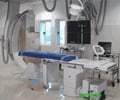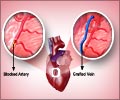- Harrison’s Principles of Internal Medicine 17th edition
About
Coronary angioplasty, also known as Percutaneous Transluminal Coronary Angioplasty, is an interventional procedure wherein blood flow is restored in a blocked blood artery supplying to the heart.
Coronary angioplasty is a procedure wherein a narrowed blood vessel supplying to the heart is widened, thus restoring the blood supply to the heart muscles.

The heart requires continuous oxygenated blood to maintain its function as a pump and supply blood to the whole body. The blood flow to the heart is maintained through the two coronary arteries – the left coronary artery, which divides into two main branches, the left anterior descending and the left circumflex artery, and the right coronary artery. Each of these arteries subsequently branches out into smaller arteries.
Atherosclerosis is a condition where excessive fat from the blood gets deposited just below the inner lining of blood vessels. This fat later thickens and becomes harder, extends towards the center of the artery and eventually blocks the artery. Thus, blood is unable to reach the tissues beyond the block, often leading to tissue damage.
Atherosclerosis affecting the coronary arteries as well as their major branches results in decreased blood supply to the particular part of the heart. This could result in death of the heart muscle supplied by the blocked artery, leading to a heart attack. If the block is incomplete, some blood flow is maintained through the narrow part, which may be enough to support the normal work of the heart. However, in conditions like during stress and exercise when the work of the heart is increased and the heart muscles require more oxygenated blood, blood flow cannot be increased through the partial block. Thus, the patient experiences chest pain, the condition being called angina.
Atherosclerosis affecting the heart is diagnosed using a procedure called angiography. In this procedure, a dye is injected into the blood vessels of the heart and the block is localized using radiological techniques.
Mild atherosclerosis is treated with drugs. If the block affecting the heart compromises blood flow, the patient has to undergo a procedure called angioplasty. This procedure helps to widen the narrowed blood vessel and restore blood flow. The angioplasty procedure was developed and performed for the first time by Dr. Andreas Gruentzig in 1977 in Switzerland. During angioplasty, a catheter with a deflated balloon is introduced till the block. The balloon is then inflated, thus widening the artery. A
Though angioplasty is a relatively safe procedure, some complications could occur like abrupt closure of the artery leading to a heart attack, perforation of the artery, reaction to the dye used during angiography and bleeding due to the blood thinners used in the procedure. The artery may also undergo restenosis (narrow again) following the procedure, requiring a repeat procedure.
Coronary bypass surgery, in which the blocked artery is bypassed using a graft, is also an option for the treatment of blocked coronary arteries. However, since it is a more complicated procedure, angioplasty is preferred in most situations wherever possible, especially if there are only one or two blocks.















